Method and device for the optical measurement of state variables and the level in a container for liquefied gases, and device therefor
- Summary
- Abstract
- Description
- Claims
- Application Information
AI Technical Summary
Benefits of technology
Problems solved by technology
Method used
Image
Examples
Embodiment Construction
[0029]FIG. 1 indicates a container for liquefied cryogenic gases only by means of its wall 1. Physical containers are generally double-walled with a highly insulating space between them. The cryogenic gas in its interior forms a gaseous phase 1.1 and a liquid phase 1.2, which is separated from the gaseous phase 1.1 by a liquid level 1.3. A device which comprises a lighting unit 2 and an evaluation unit 3, outside the container, is provided in order to determine state variables of the container content. The evaluation unit 3 comprises an image sensor 4, a computer 5 and an indication of the determined state variables or amount contained 6. Furthermore, the device comprises an optical waveguide unit, which originates from the lighting unit 2 and comprises an outer part 7 and an inner optical waveguide unit, the inner part 9, which is passed through a bushing 8 into the interior of the container 1. As described in more detail further below, the optical waveguide unit 7, 9 contains a nu...
PUM
 Login to View More
Login to View More Abstract
Description
Claims
Application Information
 Login to View More
Login to View More - R&D
- Intellectual Property
- Life Sciences
- Materials
- Tech Scout
- Unparalleled Data Quality
- Higher Quality Content
- 60% Fewer Hallucinations
Browse by: Latest US Patents, China's latest patents, Technical Efficacy Thesaurus, Application Domain, Technology Topic, Popular Technical Reports.
© 2025 PatSnap. All rights reserved.Legal|Privacy policy|Modern Slavery Act Transparency Statement|Sitemap|About US| Contact US: help@patsnap.com



